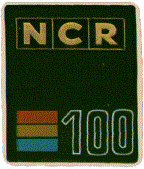
NCR Century 100
Encyclopedia

NCR Corporation
NCR Corporation is an American technology company specializing in kiosk products for the retail, financial, travel, healthcare, food service, entertainment, gaming and public sector industries. Its main products are self-service kiosks, point-of-sale terminals, automated teller machines, check...
first all integrated circuit computer. The 615-100 Series integrated a complete data processing system had 16KB or 32KB of short rod memory, 80-column card reader or paper tape reader, two 5MB removable disc drives, 600-line per minute printer. You could have a punched paper tape reader, or you could have an external card reader/punch. The system also allowed for the attachment of multiple 9 track 1/2 inch reel to reel magnetic tape drives. You could attach at least 2 more disk drives to the unit. All logic gates were created by wire-wrapping nand
NAND gate
The Negated AND, NO AND or NAND gate is the opposite of the digital AND gate, and behaves in a manner that corresponds to the opposite of AND gate, as shown in the truth table on the right. A LOW output results only if both the inputs to the gate are HIGH...
gates together to form flip-flops and other complex circuits. The console of the system had only 18 lights and switches. To start the machine you entered a hexadecimal boot strap code by setting the rotary switches. This would read a set of four boot cards that loaded the B1 operating system programs from the boot disc. A typewriter console was also available. The rotary switches also could be used to patch programs. That is, you could modify commands and program logic by entering information through the rotary switches. The computer had a clock that ran, and since most computers of the era were rented, NCR gave you so many hours a month of usage before you had to pay more. To keep the meter from running there was a halt switch, so if you wanted to either halt the current program or to simply stop the meter from running, you would put the switch in the halt mode.
Dancing Rods
The memory of the Century Series computers used machine made, short (1/16 inch long and approximately the diameter of a human hair) iron-oxide coated, ceramic rods as their random access memories, instead of the hand-labor intensive core memories that were used by other computers of the time. These rods were inserted into a plastic alignment sheet which was wound with read, write, and sense wire coils arranged in columns and rows. To get the rods to stand up straight on the sheet (so that they would drop into the coils for assembly) a large electro-magnet was turned on and made the rods stand up and ‘dance’ into the individual holes.Flying heads
The Model 655 removable disc drives were the first to employ floating or flying heads. The marketing material made a big thing of this, but there were a number of problems that plagued all of the early Century Series systems. Head crashHead crash
A head crash is a hard-disk failure that occurs when a read–write head of a hard disk drive comes in contact with its rotating platter, resulting in permanent and usually irreparable damage to the magnetic media on the platter surface....
es were common because the head flew less than a human hair's width above the disc surface. And, unless a drive unit was repaired and carefully cleaned after a crash, the next disc pack to load would also crash. If a crashed disc pack was loaded on an operational drive, it could destroy the drive unit.
A feature of the 655 drives was 12 read / write heads per surface. This reduced track to track movement and thus access times. However, this meant that there were 12 times more heads per drive, further increasing the likelihood of head crashes.
Later NCR went and got different disk units from other manufacturers as the number of head crashes were on at least some machines very common. Oddly, one location could have multiple crashes every day, and another location not have any for years. You always put the removable disc pack in the same drive, which were called D01, D02, D03, etc.
Programming Languages
The NCR Century 100 supported at least two programming languages. The first was Neat/3 which was a later version of the Neat/1 language that ran on the NCR 315NCR 315
The NCR 315 Data Processing System, released in January 1962 by NCR, was a second-generation computer. All printed circuit boards used resistor-transistor logic to create the various logic elements. It used 12-bit slab memory structure using core memory. The instructions could use a memory slab as...
computer system. The second was Cobol. The third was Fortran. The fourth was Basic.

